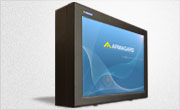Brightness Levels of Digital Signage
Posted by: Richard Williams | Posted on: | 0 Comments
One aspect of digital signage that is very rarely discussed is the importance of the right brightness level. Whether it is indoor screens or outdoor digital signage, brightness levels are an integral factor of using screens.
Not getting the brightness level right can cause several problems:
Digital Signage Dazzle
Critics of digital out of home (Dooh) often cite the potential danger of outdoor digital signage that is too bright causing dazzle to drivers, although the evidence suggests such fears are unsubstantiated. However, having too high a brightness can lead to problems, and not just outdoors.
A recent screen installation in a new basketball stadium at the University of Oregon caused terrible screen glare onto the polished floor of the basketball court. The screens, situated high up and facing down were described as “headache inducing” by some of the crowd.
This is an example of when brightness levels are too high but it can also lead to other problems such as overheating, extreme power consumption and high running costs.
Dimness
The opposite problem, however, can occur, particularly with outdoor digital signage, and often due to the sun. The brightness of the sun has to be countered with outdoor digital signage, which often means deploying a high brightness screen, to cope with sunlight when it is at its highest level.
The problem though, is that the ambient light can vary but there is no effective way of controlling the brightness of a screen automatically (at least not yet). The result is that during overcast days, or in the evening, many outdoor digital signage displays are just too bright, either threatening to dazzle drivers and costing a lot to keep running, not to mention the damage inflicted to the environment.
There are, however, several solutions that can reduce the need for running outdoor screens at such high levels. Transflective technology is one method. These screens use the ambient brightness of the sun to boost the backlight of the LCD display. The advantage of this is that when the sun is dim, such as an overcast day, the brightness can remain low, but when the sun is bright, the contrast is boosted.
Post shortlink:
Popular Products
LCD Enclosure
Need armor for your LCD/LED screen(s)? Outdoors or inside the versatile LCD enclosure protects against thieves, vandals & the weather. Installation idea: NFL stadiums.
Outdoor Digital Signage
Exclusive 46” outdoor screen protection. Dubbed the ‘Totem’, due to its distinct design, it repels damage threats, but attracts audiences. Installation idea: Drive-thru restaurants.
Portrait Flat Panel Enclosure
Safeguard your eye-level advertising display screen(s), indoors or outdoors. Completely customizable, add exciting features like touch screen technology. Installation idea: Restaurant frontages.
Indoor Digital Signage
Popular purchase for retail outlets! Great for ‘point of sale’ persuasion, boost your brand with static & motion advertising from a single unit! Installation idea: Mall of America.





